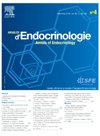阴囊热应激对撒哈拉啮齿动物睾丸组织学和功能的影响
IF 2.9
3区 医学
Q3 ENDOCRINOLOGY & METABOLISM
引用次数: 0
摘要
在这项研究中,我们研究了阴囊热应激对利比亚鼠(Meriones libycus)的影响,利比亚鼠是一种夜间活动的撒哈拉啮齿动物。材料与方法在春季睾丸活动期捕获动物,分析不同温度条件下的体重、精子质量、睾丸组织学及内分泌因子等参数。将14只成年利比亚梅里翁分为两组,每组7只。热应激组连续2天在43℃水浴中浸泡30 min,对照组在25℃水浴中浸泡30 min。动物都被献祭了。取带生殖器官的睾丸,称重固定作组织学检查。保存血浆用于激素测定和精子参数测定。结果与讨论两批动物的体重、附睾近端、精囊和前列腺腹侧重量均无显著差异。另一方面,阴囊热应激使附睾远端和睾丸重量显著降低。应激组可观察到睾丸萎缩,其特征是显著的组织学改变:精小管萎缩,生殖上皮减少为精原细胞床,精子发生停止,空腔内没有精子。这些组织学改变导致精子参数的改变:少精子症伴随着精子活力和活力的显著下降,以及精子数量的变化。应激状态下血浆睾酮水平显著下降。结论睾丸的最佳功能是在低于体温几度的温度下。当阴囊因全球变暖而暴露在更高的温度下时,间质细胞功能和精子发生受到损害,生育能力受到损害。本文章由计算机程序翻译,如有差异,请以英文原文为准。
Effects of scrotal heat stress on testicular histology and function in a Saharan rodent, Meriones libycus
Introduction
In this study, we investigated the effects of scrotal heat stress on the Libyan jird (Meriones libycus), a nocturnal Saharan rodent.
Materials and methods
For this, animals were captured during the testicular activity period in spring and parameters including body weight, sperm quality, histology of the testis and endocrine factors were analyzed under different temperature conditions. A total of 14 mature adult Meriones libycus were allocated into two groups (n = 7/each). The heat-stress group was submerged in a water bath at 43 °C for 30 min during 2 consecutive days, while the control group was treated at 25 °C. Animals were all sacrificed. The testes with reproductive organs were removed, weighed and fixed for histological examination. Plasma was preserved for hormone assays and sperm parameters were determined.
Results and discussion
Body weight, proximal epididymis, seminal vesicles and ventral prostate weights showed no significant difference between the two batches of animals. On the other hand, distal epididymis and testicular weights decreased significantly when animals were subjected to scrotal heat stress. Testicular atrophy could be observed in the stress group and characterized by remarkable histological alterations: shrunken seminiferous tubules, germinal epithelium reduced to a bed of spermatogonia with cessation of spermatogenesis and absence of spermatozoa inside an empty lumen. These histological alterations resulted in an alteration in sperm parameters: oligospermia with a considerable drop in sperm motility and vitality, and changes in the sperm count. Plasma testosterone levels dropped significantly under the stress situation.
Conclusion
These results confirm that optimal function of testicles is at a temperature a few degrees below body temperature. When the scrotum is exposed to higher temperatures as a result of global warming, Leydig cell function and spermatogenesis are impaired, and fertility is compromised.
求助全文
通过发布文献求助,成功后即可免费获取论文全文。
去求助
来源期刊

Annales d'endocrinologie
医学-内分泌学与代谢
CiteScore
4.40
自引率
6.50%
发文量
311
审稿时长
50 days
期刊介绍:
The Annales d''Endocrinologie, mouthpiece of the French Society of Endocrinology (SFE), publishes reviews, articles and case reports coming from clinical, therapeutic and fundamental research in endocrinology and metabolic diseases. Every year, it carries a position paper by a work-group of French-language endocrinologists, on an endocrine pathology chosen by the Society''s Scientific Committee. The journal is also the organ of the Society''s annual Congress, publishing a summary of the symposia, presentations and posters. "Les Must de l''Endocrinologie" is a special booklet brought out for the Congress, with summary articles that are always very well received. And finally, we publish the high-level instructional courses delivered during the Henri-Pierre Klotz International Endocrinology Days. The Annales is a window on the world, keeping alert clinicians up to date on what is going on in diagnosis and treatment in all the areas of our specialty.
 求助内容:
求助内容: 应助结果提醒方式:
应助结果提醒方式:


